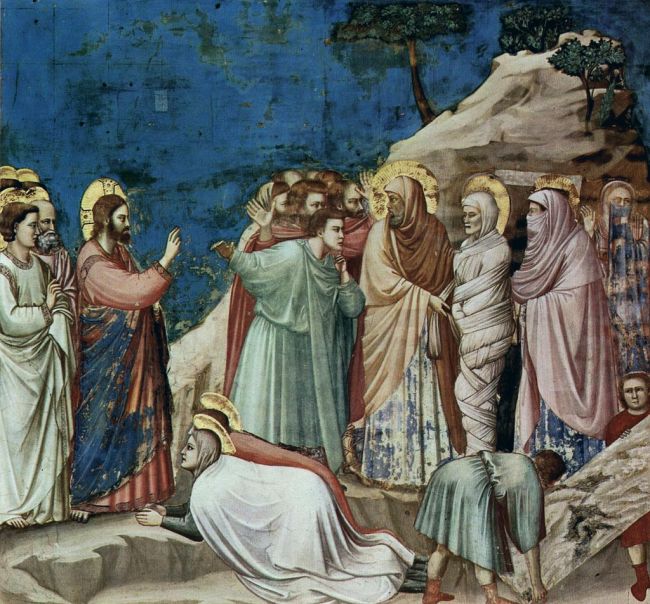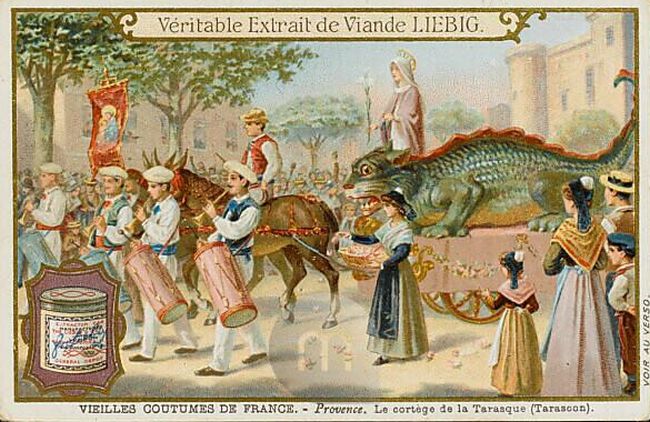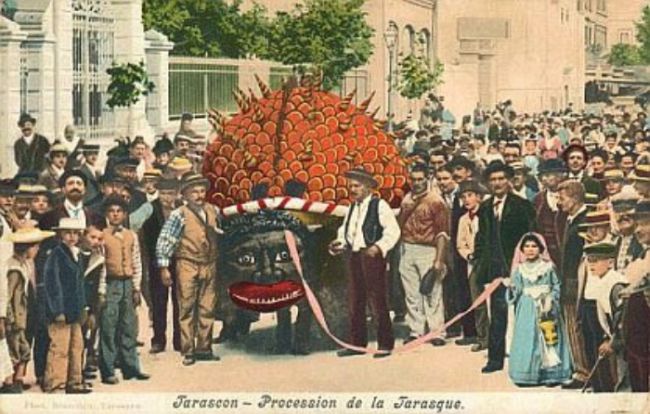St. Martha -- the Lord's worker and servant, the sister of Saints Mary Magdalen and Lazarus (all three of whom "Jesus loved" as we see in John 11:5) -- is only mentioned in three chapters of the Bible, but her character comes through clearly.
We first meet her in Luke 10:38-42, toiling in the kitchen while her sister sat at the Lord's feet:
Now it came to pass as they went, that He entered into a certain town: and a certain woman named Martha, received Him into her house. And she had a sister called Mary, who sitting also at the Lord's feet, heard His word. But Martha was busy about much serving. Who stood and said: Lord, hast Thou no care that my sister hath left me alone to serve? speak to her therefore, that she help me. And the Lord answering, said to her: Martha, Martha, thou art careful, and art troubled about many things: But one thing is necessary. Mary hath chosen the best part, which shall not be taken away from her. This is how we most often picture St. Martha -- working hard in the kitchen, serving, and being overshadowed by her more "colorful," emotionally intense sister. 1 But Martha humbly accepts His rebuke and must have heeded His words, because the next time we meet her -- it is after the death of her beloved brother, Lazarus -- she makes a profound profession of faith. Notice how boldly she asserts herself in the story of this great miracle. And note the beautiful parallel between Saints Martha and Peter as revealed in Matthew 16 and John 11. How closely her profession of faith resembles that of St. Peter!
In Matthew 16, Jesus asked Simon, "But whom do you say that I am?" Simon answered, "Thou art Christ, the Son of the living God" (Matthew 16:16), the confession that caused Our Lord to name Simon "Kepha" ("Rock") and say to him "thou art Peter; and upon this rock I will build my church, and the gates of hell shall not prevail against it." In the story of the miracle of Lazarus's resurrection, when Jesus said to Martha, "Thy brother shall rise again," she replies, "Yea, Lord, I have believed that thou art Christ the Son of the living God, who art come into this world." Read the story of Lazarus's resurrection, and be mindful of these parallels. Be aware of how this woman who exemplifies beautiful, underappreciated, and noble traditional women's work and service is no "doormat":
John 11:1-45
Now there was a certain man sick, named Lazarus, of Bethania, of the town of Mary and Martha her sister. (And Mary was she that anointed the Lord with ointment, and wiped his feet with her hair: whose brother Lazarus was sick.) His sisters therefore sent to him, saying: Lord, behold, he whom thou lovest is sick.
And Jesus hearing it, said to them: This sickness is not unto death, but for the glory of God: that the Son of God may be glorified by it.
Now Jesus loved Martha, and her sister Mary, and Lazarus. When He had heard therefore that he was sick, He still remained in the same place two days. Then after that, He said to His disciples: Let us go into Judea again.
The disciples say to him: Rabbi, the Jews but now sought to stone Thee: and goest Thou thither again?
Jesus answered: Are there not twelve hours of the day? If a man walk in the day, he stumbleth not, because he seeth the light of this world: But if he walk in the night, he stumbleth, because the light is not in him. These things He said; and after that he said to them: Lazarus our friend sleepeth; but I go that I may awake him out of sleep.
His disciples therefore said: Lord, if he sleep, he shall do well. But Jesus spoke of his death; and they thought that He spoke of the repose of sleep. Then therefore Jesus said to them plainly: Lazarus is dead. And I am glad, for your sakes, that I was not there, that you may believe: but let us go to him.
Thomas therefore, who is called Didymus, said to his fellow disciples: Let us also go, that we may die with him. Jesus therefore came, and found that he had been four days already in the grave. (Now Bethania was near Jerusalem, about fifteen furlongs off.) And many of the Jews were come to Martha and Mary, to comfort them concerning their brother. Martha therefore, as soon as she heard that Jesus had come, went to meet Him: but Mary sat at home.
Martha therefore said to Jesus: Lord, if Thou hadst been here, my brother had not died. But now also I know that whatsoever Thou wilt ask of God, God will give it thee.
Jesus saith to her: Thy brother shall rise again. Martha saith to him: I know that he shall rise again, in the resurrection at the last day. Jesus said to her: I am the resurrection and the life: he that believeth in Me, although he be dead, shall live: And every one that liveth, and believeth in Me, shall not die for ever. Believest thou this?
She saith to him: Yea, Lord, I have believed that Thou art Christ the Son of the living God, Who art come into this world.
And when she had said these things, she went, and called her sister Mary secretly, saying: The Master is come, and calleth for thee. She, as soon as she heard this, riseth quickly, and cometh to Him. For Jesus was not yet come into the town: but He was still in that place where Martha had met Him.
The Jews therefore, who were with her in the house, and comforted her, when they saw Mary that she rose up speedily and went out, followed her, saying: She goeth to the grave to weep there.
 When Mary therefore was come where Jesus was, seeing him, she fell down at his feet, and saith to him: Lord, if Thou hadst been here, my brother had not died. When Mary therefore was come where Jesus was, seeing him, she fell down at his feet, and saith to him: Lord, if Thou hadst been here, my brother had not died.
Jesus, therefore, when He saw her weeping, and the Jews that were come with her, weeping, groaned in the spirit, and troubled Himself, And said: Where have you laid him?  They say to Him: Lord, come and see. And Jesus wept. They say to Him: Lord, come and see. And Jesus wept.
The Jews therefore said: Behold how He loved him. But some of them said: Could not He that opened the eyes of the man born blind, have caused that this man should not die?
Jesus therefore again groaning in Himself, cometh to the sepulchre. Now it was a cave; and a stone was laid over it. Jesus saith: Take away the stone.
Martha, the sister of him that was dead, saith to him: Lord, by this time he stinketh, for he is now of four days. Jesus saith to her: Did not I say to thee, that if thou believe, thou shalt see the glory of God?

They took therefore the stone away. And Jesus lifting up His eyes said: Father, I give Thee thanks that Thou hast heard Me. And I knew that Thou hearest Me always; but because of the people who stand about have I said it, that they may believe that Thou hast sent Me. When He had said these things, He cried with a loud voice: Lazarus, come forth. And presently he that had been dead came forth, bound feet and hands with winding bands; and his face was bound about with a napkin. Jesus said to them: Loose him, and let him go.
Many therefore of the Jews, who were come to Mary and Martha, and had seen the things that Jesus did, believed in Him. St. Peter serves the Church as a man, and St. Martha serves as a woman -- and we honor and keep the Feasts of each!
The next and final time we see our Saint in Sacred Scripture, she is serving food just two days before the Last Supper 2 -- working faithfully in the background as when we'd first met her:
John 12:1-11
Jesus therefore, six days before the pasch, came to Bethania, where Lazarus had been dead, whom Jesus raised to life. And they made him a supper there: and Martha served: but Lazarus was one of them that were at table with him. Mary therefore took a pound of ointment of right spikenard, of great price, and anointed the feet of Jesus, and wiped his feet with her hair; and the house was filled with the odour of the ointment. Then one of his disciples, Judas Iscariot, he that was about to betray him, said: Why was not this ointment sold for three hundred pence, and given to the poor? Now he said this, not because he cared for the poor; but because he was a thief, and having the purse, carried the things that were put therein. Jesus therefore said: Let her alone, that she may keep it against the day of my burial. For the poor you have always with you; but me you have not always. A great multitude therefore of the Jews knew that he was there; and they came, not for Jesus' sake only, but that they might see Lazarus, whom he had raised from the dead. But the chief priests thought to kill Lazarus also: Because many of the Jews, by reason of him, went away, and believed in Jesus. Where Scripture leaves off, tradition steps in. We are told that Saints Martha, Mary Magdalen, and Lazarus went to southern France in A.D. 48, where St. Mary Magdalen retired to a life of penance, and St. Lazarus acted as Bishop of Marseilles. St. Martha's life in Europe was a very interesting one according to the Golden Legend: After the ascension of our Lord, when the disciples were departed, she with her brother Lazarus and her sister Mary, also S. Maximin which baptized them, and to whom they were committed of the Holy Ghost, and many others, were put into a ship without sail, oars, or rudder governail, of the  paynims, which by the conduct of our Lord they came all to Marseilles, and after came to the territory of Aquense or Aix, and there converted the people to the faith. Martha was right facound of speech, and courteous and gracious to the sight of the people.
There was that time upon the river of Rhone, in a certain wood between Arles and Avignon, a great dragon, half beast and half fish, greater than an ox, longer than an horse, having teeth sharp as a sword, and horned on either side, head like a lion, tail like a serpent, and defended him with two wings on either side, and could not be beaten with cast of stones nor with other armour, and was as strong as twelve lions or bears; which dragon lay hiding and lurking in the river, and perished them that passed by and drowned ships. He came thither by sea from Galicia, and was engendered of Leviathan, which is a serpent of the water and is much wood, and of a beast called Bonacho, that is engendered in Galicia. And when he is pursued he casts out of his belly behind, his ordure, the space of an acre of land on them that follow him, and it is bright as glass, and what it toucheth it burneth as fire. paynims, which by the conduct of our Lord they came all to Marseilles, and after came to the territory of Aquense or Aix, and there converted the people to the faith. Martha was right facound of speech, and courteous and gracious to the sight of the people.
There was that time upon the river of Rhone, in a certain wood between Arles and Avignon, a great dragon, half beast and half fish, greater than an ox, longer than an horse, having teeth sharp as a sword, and horned on either side, head like a lion, tail like a serpent, and defended him with two wings on either side, and could not be beaten with cast of stones nor with other armour, and was as strong as twelve lions or bears; which dragon lay hiding and lurking in the river, and perished them that passed by and drowned ships. He came thither by sea from Galicia, and was engendered of Leviathan, which is a serpent of the water and is much wood, and of a beast called Bonacho, that is engendered in Galicia. And when he is pursued he casts out of his belly behind, his ordure, the space of an acre of land on them that follow him, and it is bright as glass, and what it toucheth it burneth as fire.
To whom Martha, at the prayer of the people, came into the wood, and found him eating a man. And she cast on him holy water, and showed to him the cross, which anon was overcome, and standing still as a sheep, she bound him with her own girdle, and then was slain with spears and glaives of the people.
The dragon was called of them that dwelled in the country Tarasconus, whereof, in remembrance of him that place is called Tarasconus, which tofore was called Nerluc, and the Black Lake, because there be woods shadowous and black. And there the blessed Martha, by licence of Maximin her master, and of her sister, dwelled and abode in the same place after, and daily occupied in prayers and in fastings, and thereafter assembled and were gathered together a great convent of sisters, and builded a fair church at the honour of the blessed Mary virgin, where she led a hard and a sharp life. She eschewed flesh and all fat meat, eggs, cheese and wine; she ate but once a day. An hundred times a day and an hundred times a night she kneeled down and bowed her knees.
The exact nature of the (obviously now-extinct) creature being called a "dragon" is unknown (many Saints have been credited with having dealt with "dragons" -- Saints Margaret of Antioch and George being the two best-known -- and, of course, St. Michael will have his way with the Dragon of Dragons in the end!). But in any case, St. Martha's conquering of the beast known as "La Tarasque" has been commemorated in Tarascon, France (the town was named for the animal) ever since A.D. 1474 when "Good King Rene" instituted an annual celebration which continues to this day and takes place now in the last weekend of June. The town lies just between Avignon and Arles, on the left bank of the Rhone River, in a part of France famous for caves filled with "prehistoric" art. Below are two old postcards of the annual "Jeux de la Tarasque":


There are no other customs associated with St. Martha's Day that I am aware of, but her patronage makes it a natural day to honor homemakers and cooks.
Also, given that tarragon (Artemisia dracunculus sativa), or "estragon" in French, grows in the region where St. Martha lived in France, and given that the Latin botanical name for this herb means "little dragon," other ideas come to mind. Tarragon is the most powerful of the four herbs that make up "fines herbes" -- the Classic French mixture of equal parts of fresh chervil, chives, parsley and tarragon, chopped finely and added to dishes at the last minute. Fines herbes go well with eggs, salads, vegetables, chicken, and fish. Perhaps an omelette aux fine herbes, or a chicken tarragon dish would be a nice reminder of dear St. Martha.
As an aside, chewing on tarragon leaves is a very ancient cure for toothache,  and tarragon tea is said to help with sleep, menstrual cramps, and digestion. and tarragon tea is said to help with sleep, menstrual cramps, and digestion.
Tarragon Tea
1 tsp. dried tarragon
1 tsp. dried peppermint
1 cup hot water
Steep tarragon and mint in water and cover for five minutes. Discard herbs and sip warm or slightly chilled, as needed. St. Martha is the patroness of homemakers, cooks, innkeepers, domestic servants, and those whose work centers around hospitality. She is most often shown in art working in the kitchen (usually with her sister and Jesus in the foreground), at the tomb of Lazarus, crossing the sea on her way to France, or with a dragon at her feet or on a leash. Her symbols are the aspersory and/or aspergillum used to inflict holy water on the dragon, the dragon itself, a broom, and a girdle.
|


 and tarragon tea is said to help with sleep, menstrual cramps, and digestion.
and tarragon tea is said to help with sleep, menstrual cramps, and digestion.

 paynims, which by the conduct of our Lord they came all to Marseilles, and after came to the territory of Aquense or Aix, and there converted the people to the faith. Martha was right facound of speech, and courteous and gracious to the sight of the people.
paynims, which by the conduct of our Lord they came all to Marseilles, and after came to the territory of Aquense or Aix, and there converted the people to the faith. Martha was right facound of speech, and courteous and gracious to the sight of the people.
No comments:
Post a Comment